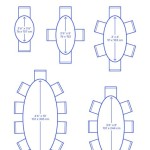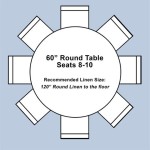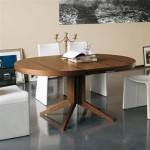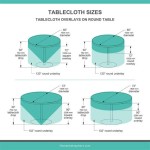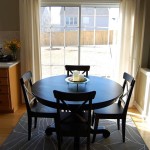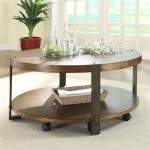What Size Rug for a 54-Inch Round Dining Table
Selecting the appropriate rug size for a dining table is crucial for both aesthetic appeal and functional practicality. A rug that is too small will make the dining area appear disjointed and may create tripping hazards. Conversely, a rug that is too large can overwhelm the space and detract from the table and chairs. When dealing with a 54-inch round dining table, several factors must be considered to ensure the rug provides ample space for chairs to be comfortably pulled out and pushed in, while also complementing the room's dimensions and overall design.
The primary consideration when choosing a rug size is the "add-on" dimension. This refers to the additional rug space needed beyond the table's diameter to accommodate chairs. The goal is to ensure that when a chair is pulled away from the table, its back legs remain on the rug. This prevents the instability of having chair legs teetering on the rug's edge, protecting flooring from potential scratches and providing a consistent, stable surface for diners. This often involves extending the rug significantly beyond the table's edge.
Another factor is the overall size of the dining room. While the add-on dimension serves as a baseline, the rug should also be proportional to the room. A very large rug in a small dining area can make the room feel cramped, whereas a rug that is too small in a spacious room can look insignificant and out of place. Balancing the rug size with the room's dimensions is key to achieving a harmonious and visually appealing design.
Furthermore, the style and material of the rug can influence the perceived size. A rug with a bold pattern can appear larger than a rug with a subtle design. Similarly, the texture of the rug can impact the room's overall feel. A thick, plush rug can add warmth and comfort, while a flatweave rug can create a more minimalist aesthetic. These elements should be considered alongside the rug's dimensions to ensure it complements the dining table and enhances the overall dining experience.
Determining the Ideal Add-On Measurement
The generally accepted guideline for the add-on measurement is a minimum of 24 inches on all sides of the table. This allows sufficient space for a chair to be pulled out comfortably without its back legs leaving the rug's surface. For a 54-inch round dining table, this means adding 48 inches to the diameter (24 inches on either side). Therefore, the minimum recommended rug diameter would be 102 inches (54 inches + 48 inches). This translates to approximately 8.5 feet.
However, this 24-inch guideline is a minimum. In some cases, a larger add-on dimension may be preferable or even necessary. For instance, if the dining chairs are particularly large or have wide bases, a larger add-on may be required to ensure adequate coverage. Similarly, if the dining area is frequently used for formal entertaining, a larger rug can create a more luxurious and spacious feel. Experimentation and visual assessment are helpful in determining if a larger add-on is warranted.
To calculate the add-on requirement more precisely, consider the depth of the dining chairs when they are pulled away from the table. Measure the distance from the front edge of the table to the back legs of the chair when someone is seated comfortably. This measurement will provide a more accurate representation of the required add-on dimension. If this measurement exceeds 24 inches, adjust the rug size accordingly.
It is also important to consider the presence of any surrounding furniture or architectural elements. If the dining area is located near a doorway or a wall, ensure the rug does not extend into these areas, creating obstructions or tripping hazards. The rug should be positioned in a way that allows for smooth and unobstructed movement around the dining table.
Considering the Room's Dimensions and Shape
While the add-on measurement provides a baseline for rug size, the overall dimensions and shape of the dining room must also be taken into account. A rug that is perfectly sized according to the add-on guideline may still appear disproportionate if it does not complement the room's dimensions. A large room can handle a larger rug, while a smaller room may require a smaller rug to avoid overwhelming the space.
In a large dining room, a rug larger than the minimum recommended size can help to define the dining area and create a sense of cohesiveness. A rug that extends beyond the dining table and chairs can visually anchor the space and create a more intimate atmosphere. However, it is important to ensure the rug does not extend too far, encroaching on other areas of the room or creating a disjointed layout.
In a smaller dining room, a rug that is closer to the minimum recommended size may be more appropriate. A smaller rug can help to create the illusion of more space, preventing the room from feeling cramped or cluttered. However, it is crucial to ensure the rug still provides adequate coverage for the chairs, even if it is smaller overall. A trial-and-error approach, using painter's tape to mark out potential rug dimensions on the floor, can be helpful in visualizing the impact of different rug sizes.
The shape of the room can also influence the optimal rug size. In a square or rectangular dining room, a square or rectangular rug may be the most aesthetically pleasing choice. However, in a more irregularly shaped room, a round rug may be a better option for complementing the room's geometry. The key is to choose a rug shape that harmonizes with the room's overall design and creates a sense of balance.
In some cases, a custom-sized rug may be the best option for achieving the perfect fit. Custom rugs can be tailored to precisely match the dimensions and shape of the dining room, ensuring a seamless and cohesive look. While custom rugs can be more expensive than standard-sized rugs, they offer the advantage of a perfect fit and the ability to choose specific materials, colors, and patterns.
Material, Style, and Color Considerations
Beyond size and shape, the material, style, and color of the rug play a significant role in the overall aesthetic of the dining area. The material of the rug can impact its durability, comfort, and ease of maintenance. The style of the rug can complement the dining table and chairs, enhancing the room's overall design. The color of the rug can create a specific mood or atmosphere, influencing the dining experience.
For dining areas that experience high foot traffic or are prone to spills, durable and stain-resistant materials such as wool or synthetic fibers are recommended. Wool rugs are known for their resilience and natural stain resistance, while synthetic rugs such as nylon or polypropylene are more affordable and easier to clean. Flatweave rugs are also a practical choice for dining areas, as they are less likely to trap crumbs and debris.
The style of the rug should complement the style of the dining table and chairs. For a traditional dining area, a rug with a classic Persian or Oriental design can add a touch of elegance and sophistication. For a more modern dining area, a rug with a geometric pattern or a minimalist design can create a sleek and contemporary look. The key is to choose a rug style that harmonizes with the existing furniture and enhances the room's overall aesthetic.
The color of the rug can significantly impact the mood and atmosphere of the dining area. Lighter colors can create a bright and airy feel, while darker colors can create a more intimate and cozy atmosphere. Neutral colors such as beige, gray, or ivory are versatile and can complement a wide range of dining table and chair styles. Bold colors such as red, blue, or green can add a pop of personality to the room, but should be used sparingly to avoid overwhelming the space.
In addition to the rug's color, consider its pattern. A rug with a large-scale pattern can make a small dining area feel larger, while a rug with a small-scale pattern can add visual interest without overwhelming the space. If the dining table and chairs are already patterned, a rug with a solid color or a subtle texture may be the best choice. Conversely, if the dining table and chairs are plain, a rug with a bold pattern can add a focal point to the room.
Ultimately, the choice of rug size, shape, material, style, and color is a matter of personal preference and should be guided by the specific needs and aesthetic goals of the dining area. By carefully considering these factors, it is possible to select a rug that not only complements the 54-inch round dining table but also enhances the overall dining experience.

Round Rug Size Guide For 36 42 48 54 60 72 Inch Tables Rugs Direct

Round Rug Size Guide For 36 42 48 54 60 72 Inch Tables Rugs Direct

Round Rug Size Guide For 36 42 48 54 60 72 Inch Tables Rugs Direct

Rules Of Thumb For Rugs Under Round Dining Tables Inspiration

Round Rug Size Guide For 36 42 48 54 60 72 Inch Tables Rugs Direct

Rules Of Thumb For Rugs Under Round Dining Tables Inspiration
.jpg?strip=all)
What S The Best Rug Size For A Round Dining Table Bloom In Black
Round Rug Size Guide For 36 42 48 54 60 72 Inch Tables Rugs Direct

Pin On Home

Rules Of Thumb For Rugs Under Round Dining Tables Inspiration
Related Posts

